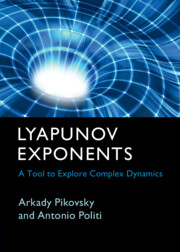Book contents
- Frontmatter
- Contents
- Preface
- 1 Introduction
- 2 The basics
- 3 Numerical methods
- 4 Lyapunov vectors
- 5 Fluctuations, finite-time and generalised exponents
- 6 Dimensions and dynamical entropies
- 7 Finite-amplitude exponents
- 8 Random systems
- 9 Coupled systems
- 10 High-dimensional systems: general
- 11 High-dimensional systems: Lyapunov vectors and finite-size effects
- 12 Applications
- Appendix A Reference models
- Appendix B Pseudocodes
- Appendix C Random matrices: some general formulas
- Appendix D Symbolic encoding
- Bibliography
- Index
Appendix D - Symbolic encoding
Published online by Cambridge University Press: 05 February 2016
- Frontmatter
- Contents
- Preface
- 1 Introduction
- 2 The basics
- 3 Numerical methods
- 4 Lyapunov vectors
- 5 Fluctuations, finite-time and generalised exponents
- 6 Dimensions and dynamical entropies
- 7 Finite-amplitude exponents
- 8 Random systems
- 9 Coupled systems
- 10 High-dimensional systems: general
- 11 High-dimensional systems: Lyapunov vectors and finite-size effects
- 12 Applications
- Appendix A Reference models
- Appendix B Pseudocodes
- Appendix C Random matrices: some general formulas
- Appendix D Symbolic encoding
- Bibliography
- Index
Summary
In this appendix we briefly introduce the basic elements of a powerful approach that helps to characterise chaotic dynamical systems and eventually to obtain accurate estimates of its Lyapunov exponents. The idea is to partition the phase space into a collection P of disjoint elements {Bi} (the atoms) and thereby encode a generic trajectory {Un} as a sequence of symbols {sn}, where sn = Bi if Un ∈ Bi. The procedure is faithful only if the partition P is generating; i.e. an infinitely long trajectory is encoded by one and only one sequence of symbols.
In maps of the interval, a generating partition can be constructed by splitting the interval itself into subsets, where the map behaves monotonously (Collet and Eckmann, 1980). For instance the logistic map (A.2) U’ = aU(1 - U) has a maximum in U = 1/2, and its dynamics can be thereby encoded as a sequence of binary symbols, which are selected depending on whether the phase point belongs to the interval [0, 1/2) or [1/2, 1].
In two-dimensional spaces, the problem of constructing a generating partition is much harder. No rigorous results are, in fact, available, but there is compelling evidence that a method proposed by Grassberger and Kantz (1985) for the Henon map works for generic dissipative models. It makes use of the homoclinic tangencies (i.e. the points where stable and unstable manifolds are mutually tangent). In practice, the two-dimensional plane is split into two parts by the polygonal line obtained by connecting the so-called primary tangencies (approximately, those characterised by a minimal value of the sum of the curvature of the two manifolds). As shown by Giovannini and Politi (1992) and Hansen (1992), the final result is not unique: a given dynamical system can be characterised by equivalent but different symbolic descriptions.
The approach can be extended to symplectic systems by complementing the use of homoclinic tangencies with that of suitable symmetry lines, which allow the partitioning of the ordered regions where no tangencies are present (Christiansen and Politi, 1997).
By definition, any trajectory of a map F(U) is encoded as a suitable symbolic sequence, but the converse is not generally true; typically, there exist infinitely many sequences that cannot be generated by a given mapping F. This information is implicitly contained in the value of the topological entropy.
- Type
- Chapter
- Information
- Lyapunov ExponentsA Tool to Explore Complex Dynamics, pp. 258Publisher: Cambridge University PressPrint publication year: 2016



